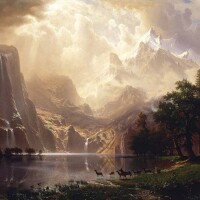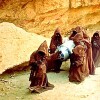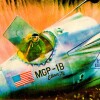Connected to the Land: the Work of Laura Aguilar

In the ongoing debate between nature versus nurture, it is possible that both have an equal and unquantifiable effect on the making of a human person. Nowhere is this more evident than in the oeuvre of artist Laura Aguilar, whose friendship I have enjoyed for many decades.
As part of her retrospective at the Vincent Prince Museum of Art, “Laura Aguilar: Show and Tell” last September 2017 — itself a part of the Getty’s Pacific Standard Time: LA/LA initiative — she and I agreed to collaborate to produce a biographical piece for the exhibition catalog, focusing on her family history.
From our very first conversation, I realized that her ancestral maternal lineage ran deep into the Mexican and Native populations of the San Gabriel River basin and that she possessed a significant oral history of her maternal line. Not only that, but that the Rio Hondo riverbeds of the west San Gabriel Valley have equally informed her work, in particular, her later series of nude self-portraits in nature.
Aguilar began her photographic journey, in the late 1970s as a high school student following her brother’s interest in photography. By the 1990s she emerged as a stunning young voice in the Chicano visual art world of East Los Angeles and in fine art photography, with performative, self-portrait nudes that took issue with conventional notions of the female body, body size, as well as ethnic and sexual identity. By the millennium, Aguilar’s photographs consistently challenged and subverted normative ideas and conceptions about the often invisible and disempowered, large, brown, female body. With her now iconic triptych, “Three Eagles Flying,” Aguilar set the stage for her future work by using her nude body as an overt and courageous rebellion against the colonization of Chicana identities: racial, gendered, cultural and sexual. In this piece, Aguilar’s semi-nude body is flanked by images of the Mexican and the American flag. Her body is partially covered, the eagle of the Mexican flag covering her head while the American flag wraps around her lower body, both of which are held in place by a thick rope which functions as both noose and shackle. This is a deeply personal piece, drawing upon conflicting emotions Aguilar experienced as a child when she lacked the ability to verbally express reactions to her family dynamics, her relationship with her mother, the loss of her grandmother, her skin color, her body weight, her limited language abilities in English and lack of Spanish, and the challenges of navigating her racial and cultural identity, as Mexican, Mexican American and American.

Yet by using the body to center her visual discourse, Aguilar never intended her work to speak for any specific political and/or feminist ideology. On the contrary, the work intuitively evolved over time as she struggled to negotiate and navigate her ethnic and sexual identity, her challenges with depression and auditory dyslexia and the acceptance of her large body.


The Edge of Nothingness

Laura Aguilar and I are driving North up Del Mar Avenue in Rosemead. We are coming from her favorite restaurant, Norm’s on Beverly and Rosemead Boulevard in Pico Rivera, talking about art, photography, childhood memories and the South San Gabriel neighborhood she grew up in. Relating to the bleak suburban sprawl, not far from where I myself grew up, I tell Laura, “so basically, we both come from a cultural desert,” which makes her laugh, concurring with me, saying, “Yeah, I used to tell people I grew up on the edge of nothingness!”
In retrospect, however, I came to understand this was not really the edge of nothingness, but rather the center of a familial place in early Mexican Californio history where Aguilar’s maternal lineage is significantly linked to the San Gabriel river basin and Mission lands before both the Mexican and American occupation periods. More specifically, her family history connects to the historically-significant rancho Potrero Chico or Potrero de la Misión Vieja de San Gabriel in Mexican California, which was also the home for thousands of years to Kizh-Gabrieleno Indian villages commonly known as Shevaanga or Siba and Isanthcag-na.
Aguilar’s family heritage is native Californio, Mexican and Irish. Her father, Paul Aguilar was second-generation Mexican-American, born in Los Angeles to Mexican immigrant parents who left Mexico during the Mexican Revolution. Aguilar’s mother, Juanita Grisham was at least fifth generation documented Mexican-Californio native on her mother, Maria (Mary) Ramona Salgado’s side and Irish American on her father, Luther Grisham’s side. Her maternal lineage is rooted in the community known as the Old Mission community or la Misión Vieja, which grew out of several ranchos created out of the former lands of the Mission San Gabriel, which was originally established along the Rio Hondo river just north and east of San Gabriel Boulevard and west of Rosemead Boulevard in 1771 and then moved to its current location within about three years. Before that, the Gabrieleño Indian villages were likely on or near the same spot. Mary Salgado’s mother, Nasaria Andrade Salgado was born and raised in the Old Mission community, where both she and her mother, Antonia Andrade married Mexican immigrant men and raised large families. While I could find no detailed records of Antonia Andrade’s California-born parents, it is very likely that their lineage dates back one, if not more generations to the pre-Mexican period and possibly into the pre-Spanish periods in Southern California, perhaps placing Aguilar’s lineage within the native populations who lived on or near San Gabriel Mission lands.
Throughout our conversations, I discovered Aguilar’s art was early on nurtured by the women in her family, including her grandmother Mary, a woman of the river, who collected rocks and shared with Aguilar the beauty of the land and its natural formations. Her blind Aunt Inez taught her to see like an artist, requesting Aguilar to frequently describe the daytime light, the colors of flowers, the formations of rocks and surrounding nature in as best of detail that she could, while her mother taught her about the tapestry of the human face. Juanita loved to look at people with the sensitivity of an artist, expressing to her daughter the details of portraiture: facial features, expressions, textures and skin color, elements that could reveal a deeper nature of those they observed. These were precious lessons Aguilar never forgot and in time they would become foundational in her early photography.
By the 1980s, Aguilar’s photography was largely focused on portraiture, at times including self-portraits, that centered on the Chicano/Latino community as she navigated her ethnic and cultural identity and the LGBT community, developing a powerful visual oeuvre as a Latina lesbian art activist. Her series, “Latina Lesbians” took an early documentary view of professional Latinas whose portraits were augmented by personal texts regarding their sexual preference and self-esteem. Adding to this conversation was Aguilar’s “Plush Pony” series, offering candid portraits of women who frequented the lesbian bar, the Plush Pony in El Sereno. These portraits offer a rarely seen glimpse into Los Angeles’ alternative community spaces at the time the city was in crisis following the Rodney King verdicts and subsequent civil unrest.

The 1990s found Aguilar’s work increasingly bridging the diversity of Los Angeles, depicting African-Americans, Latinos and LGBTs as the focus of her portraiture, as well as deepening the visual analysis of her identity as a large bodied, brown, lesbian, Chicana woman. Her largest series “Clothed/Unclothed” begins with Aguilar herself posing both clothed and unclothed, the first of over 30 diptychs featuring an intimate and diverse view of community in clothed and unclothed portraits.
Beginning the decade with the now-iconic works, How Mexican is Mexican, In Sandy’s Room, “Three Eagles Flying” and the series, “Clothed/Unclothed,” the decade closes with three nude self-portrait series in nature, “Nature Self Portrait, Stillness” and “Motion.” Aguilar’s series of nude self-portraits shot at Joshua Tree National Monument in 2007, Grounded, is the final series the artist would produce before both financial and health concerns limited her abilities to travel and work outdoors. It is in Grounded, however, where Aguilar fully and completely merges with the landscape, the forms of the large boulders frame the contours of her body while, Aguilar herself becomes the landscape. While these series do not feature her Rio Hondo river basin roots, but rather desert landscapes of New Mexico, the river and woodlands of Southern Texas and the monumental boulders of California’s Joshua Tree National Monument, it is nevertheless Aguilar’s maternal lineage of river women that echo throughout her compositions.

The recent retrospective “Laura Aguilar: Show and Tell” at the Vincent Price Art Museum showcased over three decades of work of the photographer and it told the story of the artist who for most of her life struggled to communicate with words yet ironically emerged as a powerful voice for numerous and diverse groups including Feminist, Gay/Lesbian, Chicanx and Latinx communities. From early portraits of family members to the deeply personal revelations of her nude self-portraits, her work reveals her own truth with openness and honesty. Aguilar’s images of women, of Chicana/Latina women and women of color, and particularly of the marginalized, large, female body are curative, visual meditations. They are powerful signifiers of difference and the impact of otherness in our society, and on a deeper level speak to the patriarchal, gendered, colonial paradigms in which we all live. The brown, female body at the center of Aguilar’s work in not only the artist herself, but her half Irish, light-skinned mother Juanita, free-spirited grandmother Mary, great-grandmother Nasaria and great-great grandmother Antonia and back towards the ancient female lineage that goes before them, Mexican women from the El Monte Township and la Misión Vieja to the native women from the Kizh-Gabrieleno villages of the sacred San Gabriel watershed. They are speaking to us through the gelatin silver print with Aguilar as artist mediator, whose job it is to heal us all. As Aguilar bears witness to the untold stories and struggles of these women, unknown and invisible, as well as to her own story, they become us and we are all empowered in the process.
Top Image: Laura Aguilar, Nature Self-Portrait #2 , 1996 | Courtesy of the artist and the UCLA Chicano Studies Research Center. © Laura Aguilar








